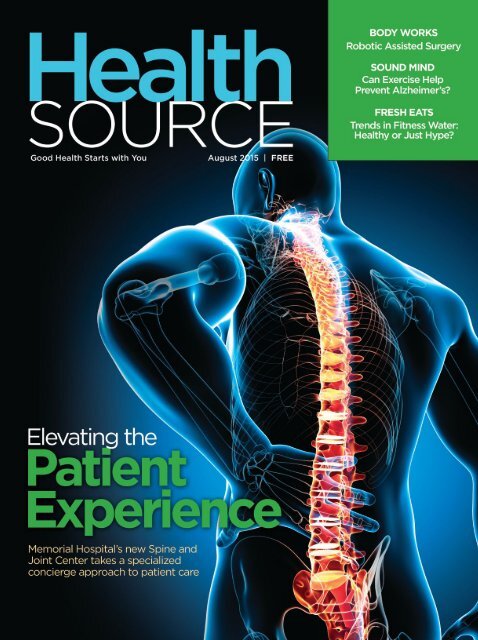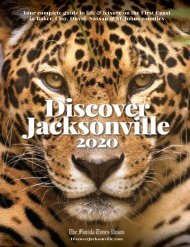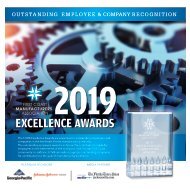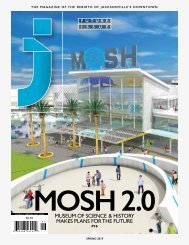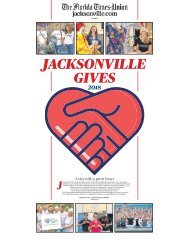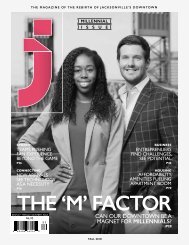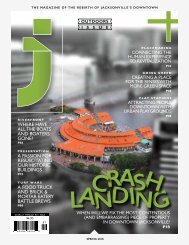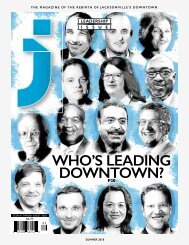HealthAug15
Create successful ePaper yourself
Turn your PDF publications into a flip-book with our unique Google optimized e-Paper software.
SPONSORED CONTENT<br />
ELEVATING<br />
the<br />
Patient Experience<br />
Memorial Hospital’s new Spine and Joint Center takes<br />
a specialized concierge approach to patient care<br />
By Nan Kavanaugh<br />
It is 6 o’clock in the morning, and you lay in your hospital<br />
bed awake, but groggy. You are less than 24 hours out of a<br />
lengthy spine surgery, and wondering what medicine you had<br />
been given. To your right, your wife is there, sitting quietly<br />
at a desk typing away on her laptop. A nurse walks in, and<br />
you ask her about the medication. Without even glancing at<br />
your chart, she rattles off a short list and lets you know that<br />
physical therapy will begin at 8 a.m. in the gym across the<br />
hall. The nurse doesn’t need to read a note on a chart to tell<br />
her where you are at in your recovery process, because she<br />
has been by your side since your surgery the day before.<br />
Stephen Scibelli, M.D.<br />
Eleanor Lynch<br />
At Memorial Hospital’s new<br />
Spine and Joint Center,<br />
patients will experience<br />
specialized care in a<br />
manner that will never leave them<br />
questioning. From the moment you<br />
make your first appointment, a highly<br />
trained staff dedicated to providing<br />
you with a streamlined optimal<br />
experience will be there to support<br />
you every step of the way.<br />
“First and foremost, our approach is<br />
to ask what would we do for ourselves,<br />
and how would we do it?” says<br />
Stephen Scibelli, M.D., Neurosurgeon<br />
at Memorial Hospital. “We put the<br />
best people with the best training in<br />
those positions and dedicate them to<br />
providing the best outcome for that<br />
individual. We want the patient to be<br />
able to understand the depth of care at<br />
every level.”<br />
Every member of the staff at the<br />
Spine and Joint Center at Memorial<br />
Hospital, from the highly specialized<br />
surgeons, to the physical therapists,<br />
to the nurses, is trained specifically<br />
for neuro-ortho surgeries – from the<br />
most complex procedures to the more<br />
common back surgeries.<br />
“Many hospitals rotate nurses<br />
through different service lines, but<br />
here you have a trained team focused<br />
only on spine and joint surgical care,”<br />
says Dr. Scibelli. “Think of it as taking<br />
your car to a specialized car mechanic<br />
as opposed to a general car mechanic.”<br />
Recognizing that every patient’s<br />
needs are different is essential to the<br />
philosophy of the team at the Spine<br />
and Joint Center, and being able to<br />
meet those needs from the start of their<br />
care cycle to the end is imperative.<br />
A nurse navigator will act as a guide,<br />
helping to educate both the patient<br />
and their family about the process.<br />
“It is not just enough to perform a<br />
surgery anymore, but you have to<br />
provide a full continuum of care,” says<br />
Eleanor Lynch, Senior Vice President<br />
of Operations at Memorial Hospital.<br />
“You have to not only consider the<br />
patient experience, but also the family<br />
experience,” she says.<br />
When you walk into the lobby of<br />
the Spine and Joint Center you will<br />
find yourself in a warm, comfortable<br />
environment. The patient rooms are<br />
being designed to create a sense of<br />
home, not just for the patient, but also<br />
for the comfort of the family member<br />
or support person there to help.<br />
“Some of this is about comfort,<br />
but really it is about improving the<br />
experience so the patient will maintain<br />
a positive outlook, which can shape<br />
recovery,” says Dr. Scibelli. “Patients<br />
will be immediately put into a recovery<br />
role, not a sick patient role.”
“Some of this is<br />
about comfort,<br />
but really it is<br />
about improving<br />
the experience so<br />
the patient will<br />
maintain a positive<br />
outlook, which can<br />
shape recovery.<br />
Patients will be<br />
immediately put<br />
into a recovery<br />
role, not a sick<br />
patient role.”<br />
— Stephen Scibelli, M.D.<br />
Memorial Hospital offers a premium<br />
patient experience from the moment<br />
you walk in the door with cutting-edge<br />
services and exceptional care.<br />
From start to finish, the end goal is<br />
to provide patients with a full recovery<br />
as smoothly as possible. With back<br />
surgeries, post-operative care is a<br />
critical part of that process.<br />
“The nurse navigator will help<br />
educate the patient as well as the<br />
family or support person on the<br />
exercises necessary for optimal postoperative<br />
care,” says Lynch.<br />
Streamlining post-operative<br />
recovery is a primary focus of the<br />
Spine and Joint Center. There will<br />
be a designated gym for neuro-ortho<br />
patients, allowing for more privacy and<br />
to focus on the specific needs of each<br />
individual’s recovery. The patients will<br />
be working with the same therapists<br />
day in and day out, developing more<br />
personal relationships with their care<br />
provider at a time in their lives when<br />
they feel most vulnerable.<br />
“This close relationship gives the<br />
practitioners the opportunity to<br />
connect with their patients. The oneon-one<br />
care gives them a chance to<br />
see the patient progress through, and<br />
celebrate the reward of a complete<br />
recovery, rather than just a snap<br />
shot,” says Dr. Scibelli.<br />
It is that commitment to a full<br />
recovery that drives the Spine and<br />
Joint Center team at Memorial<br />
Hospital. Their goal is for patients<br />
to return to daily life as quickly as<br />
possible. By creating the Spine and<br />
Joint Center, it is their hope that the<br />
exceptional level of care and track<br />
record of complete recovery will<br />
transform the unit into a national<br />
destination for neuro-ortho surgery.<br />
By creating a concierge-like service,<br />
Memorial Hospital is investing in<br />
the quality of a tailored patient<br />
experience, not just the clinical<br />
outcome. Memorial Hospital is<br />
investing in the quality of a tailored<br />
patient experience, not just the<br />
clinical outcome. For them, the two<br />
are intertwined.<br />
“We are going to facilitate you in<br />
reaching your own goals as a patient,<br />
not our goals as practitioners. This<br />
is about your level of comfort, and<br />
we are going to be there with you<br />
through the entire process,” says<br />
Dr. Scibelli. “We want you to achieve<br />
an outcome that will return you to<br />
your optimal life.”<br />
memorialspine& joint<br />
3625 University Blvd, Jacksonville, FL 32216<br />
(904) 296-2522<br />
www.memorialneurospine.com
letter from the publisher ••••<br />
PUBLISHER<br />
A.J. Beson<br />
EXECUTIVE VICE PRESIDENT<br />
Michael E. Hicks<br />
EDITOR / COMMUNITY MANAGER<br />
Nan Kavanaugh<br />
ART DIRECTOR<br />
Christine Tarantino<br />
DIRECTOR OF BUSINESS DEVELOPMENT<br />
Stephanie Calugar<br />
MARKETING CONSULTANTS<br />
Alaina Record<br />
Joy Bell<br />
Adam Farmer<br />
Nikki Schonert<br />
GRAPHIC DESIGNERS<br />
Courtney Cooper<br />
Andy Gattis<br />
COPY EDITOR<br />
Sarah Musil<br />
CONTRIBUTING WRITERS<br />
Bob Fernee<br />
Maggie FitzRoy<br />
Cheryl B. Lemine<br />
Eleanor Snite<br />
Jon Vredenburg<br />
PROJECT MANAGER AND<br />
SOCIAL MEDIA STRATEGIST<br />
Stacey Steiner<br />
PROJECT MANAGER<br />
Chris Day<br />
FINANCIAL OFFICER<br />
Sonia Wellington<br />
AGENCY ACCOUNT COORDINATOR<br />
Michael Bridge<br />
VIDEO PRODUCTION SPECIALIST<br />
Grace Walsh<br />
INTERNS<br />
Tre Daniels<br />
Lauren Hanna<br />
Nicole Letendre<br />
Being active is an important part of everyday life.<br />
Until very recently, every single<br />
day I was enjoying a brisk run,<br />
participating in soccer games, and<br />
playing hockey every Wednesday<br />
night with some of my best<br />
friends. Back pain has always been<br />
something that’s come in and out<br />
of my life as I’ve gotten older, but<br />
this time, it was another sort of<br />
beast. After a visit with my doctor<br />
and a back specialist, it turns out<br />
that I have a bulging disk in my<br />
back that is irritating the nerve. It’s<br />
been so hard not being able to get<br />
out and be athletic.<br />
Taking part in sports isn’t just<br />
about the exercise, which is very<br />
important, but it helps the body<br />
function more effectively and<br />
efficiently. It is one of the best<br />
ways to stay active. It gets all the<br />
muscles to work in sync with one<br />
another. This provides you with<br />
the strength you never knew you<br />
could have and an overall healthy<br />
well-being. Physical benefits aside,<br />
the United Nations Sports for<br />
Development and Peace says that<br />
kids should be highly encouraged<br />
to take up a sport early on to<br />
enhance their developing social<br />
skills.<br />
For us adults, they say when<br />
participating in sports you can<br />
improve your mental alertness over<br />
time.<br />
Get out there, it’s never too late and<br />
you’re never too old to join a team<br />
or league! Maintaining an active<br />
lifestyle with friends and community<br />
is so motivating.<br />
Best Regards,<br />
A.J. Beson<br />
CEO & Publisher<br />
aj@beson4.com<br />
Stock photography provided by Thinkstock<br />
HealthSourceMag.com<br />
HealthSource is published by Beson4 Media Group, 13500<br />
Sutton Park Drive South, Suite 105, Jacksonville, FL 32224,<br />
904.992.9945. Content of the contributing advertisers do not<br />
reflect the opinions of Beson4 Media Group. Advertisers have<br />
proofed respective articles and content is assumed true and<br />
correct. HealthSource is not responsible for the care given by<br />
its advertisers. HealthSource is for informational purposes only<br />
and is not meant as medical advice. HealthSource believes that<br />
choosing a medical professional is a serious decision and should<br />
not be based solely on an advertisement. © 2015 HealthSource,<br />
Inc. All rights reserved. The contents of this publication including<br />
articles, may not be reproduced in any form without the<br />
written permission from the publisher.<br />
I would like to dedicate<br />
this issue of HealthSource<br />
Magazine to my sister-in-law<br />
Monica Seifried, loving wife,<br />
mother, sister, and friend.<br />
She was an inspiration to<br />
all who knew her.<br />
(1973-2015)<br />
4—HealthSource August 2015
Over the past decade, we have increasingly grown to serve our patients in Northeast Florida.<br />
For patient convenience, we are moving our main location, 3900 University Blvd. South, Jacksonville<br />
to 7011 AC Skinner Parkway, Jacksonville starting in September 2015. Our new office, equipped with<br />
more exam rooms and more parking, will reduce wait time for patients because<br />
quality care comes first.<br />
OUR NEW HOME IS AT:<br />
7011 AC SKINNER PARKWAY, JACKSONVILLE<br />
904.493.3333<br />
We will maintain a satellite office on University Blvd. while all of our other locations, including our outpatient<br />
cath lab, will remain the same. Visit our new location for improved quality, the same lower out-of-pocket costs<br />
and the same expert team.<br />
www.firstcoastcardio.com
22<br />
August 2015<br />
contents<br />
26<br />
14<br />
Features<br />
14 Robotic Precision<br />
Advances in robotic<br />
technology ensure the<br />
best benefits of joint<br />
replacement surgery.<br />
22 Can Exercise<br />
Help Prevent<br />
Alzheimer’s<br />
Disease?<br />
Two important<br />
studies investigate if<br />
physical activity can<br />
make a difference<br />
in postponing<br />
Alzheimer’s, or its<br />
effects.<br />
27 Trends in<br />
Fitness Waters<br />
Many people seek<br />
beverages that give<br />
their bodies much<br />
more than just H 2 O—<br />
but do fitness waters<br />
really offer a way to<br />
improve health, or do<br />
they just offer hype?<br />
BODY WORKS<br />
10 Best Foot Forward<br />
Tips and tricks to help<br />
put you in first place.<br />
13 Ask the Expert<br />
Phil Squatrito, owner<br />
and coach at Training for<br />
Warriors—Ponte Vedra<br />
Beach, shares his thoughts<br />
on motivation and fitness.<br />
18 Exercise of the Month<br />
Three ways to ramp up<br />
and achieve a faster<br />
running pace.<br />
SOUND MIND<br />
21 Healthy Minute<br />
5 facts about Alzheimer’s<br />
disease and finding a<br />
community of support<br />
to navigate its uncharted<br />
waters.<br />
FRESH EATS<br />
32 What’s On Our Plate<br />
The restrictions of the<br />
Whole30 program<br />
may seem wholly<br />
extreme, but this is<br />
no squirrel food diet.<br />
34 Grow Your Own<br />
Since okra loves the heat,<br />
Florida’s sunny climate<br />
makes it a good summer<br />
vegetable-garden crop.<br />
6—HealthSource August 2015
PRESENTED SPONSOR<br />
SPIRIT SPONSORS<br />
SILVER SPONSORS<br />
ST. VINCENT’S<br />
H E A L T H C A R E<br />
®<br />
Food & Beverage Providers:
healthsourcemagazine / healthsourcemag<br />
FIND IT<br />
Online<br />
@healthsourcemag<br />
/ healthsourcemag<br />
Seasonal Eats:<br />
Looking for a great recipe<br />
featuring veggies in<br />
season? Visit us online for<br />
some recipes for a fresh<br />
menu at the table.<br />
Hula in the City<br />
Photo Gallery:<br />
Did you miss our<br />
HealthSource Hula in the<br />
City: A Celebration of<br />
Nurses event this year…<br />
but want to check out the<br />
fun? Visit us online to see<br />
pictures from our<br />
annual bash!<br />
Keep your Brain in the Game:<br />
Even though your brain has wrinkles, it<br />
doesn’t mean that you can’t keep it in great<br />
shape! Visit us online for some activities to<br />
keep your mind fit.<br />
Happy<br />
Hydrating!<br />
It is the hottest<br />
time of year,<br />
which means<br />
it is so important<br />
to stay hydrated.<br />
Looking for some<br />
new twists on<br />
water? Visit us<br />
online for<br />
simple<br />
recipes.<br />
8—HealthSource August 2015
BODY WORKS • • • • Best Foot Forward<br />
the scoop on<br />
RUNNING<br />
WEAR<br />
By Bob Fernee<br />
If you have been trying to run outside lately, no doubt you’ve noticed that your<br />
trusty cotton t-shirt has let you down.<br />
It absorbs your perspiration, becoming heavy, sopping<br />
wet and downright nasty. Perhaps you’ve thought about<br />
those “technical” shirts that are supposed to be so<br />
wonderful, but also wondered, “Are they that good? Can<br />
they really help me in this relentless heat and humidity?”<br />
In 1986, DuPont invented a fabric called “Coolmax.”<br />
It was polyester, but woven in a new and different way. Using<br />
“capillary action,” the fabric transported moisture away from<br />
the skin and put it on the outside of the fabric, where it would<br />
evaporate more quickly. This made the user feel dryer and<br />
more comfortable.<br />
Coolmax was an immediate success, and soon showed up<br />
in socks, sports bras and shorts. Every big name sportswear<br />
company used it. After several years, these companies seemed<br />
to ask themselves, “Why are we paying DuPont to use<br />
Coolmax, when we could develop our own tech?” Nike was<br />
quick to make Dri-Fit, Adidas followed with ClimaCool, and<br />
all the other major brands soon had their own labels as well.<br />
10—HealthSource August 2015
Today, the name Coolmax is rarely<br />
seen or heard, and when people refer<br />
to these fabrics they use the descriptors<br />
“wicking,” “moisture-management” and<br />
“technical.”<br />
The next development was in giving<br />
the fabrics a tighter, body-hugging<br />
fit. In order to accomplish this, Lycra<br />
was added. These stretchy garments<br />
wicked the moisture more efficiently<br />
and did a better job of regulating body<br />
temperature.<br />
Do these tech fabrics really work?<br />
Yes, but before tech fabrics came to<br />
running apparel, they were used in<br />
ski wear. For athletes working up a<br />
moderate sweat on a cool, dry ski<br />
slope, the fabrics work very well. In<br />
the Florida heat and humidity, even the<br />
best wicking fabric can’t completely<br />
keep up with the torrent of perspiration<br />
generated by a workout. In other times<br />
of the year perhaps, but in the summer<br />
you are not going to feel “dry” like the<br />
product descriptions claim. However,<br />
as compared to cotton, when wearing<br />
tech garments you will feel lighter,<br />
more comfortable, and have a reduced<br />
chance of chaffing.<br />
There is tech, and there is better tech.<br />
The tech t-shirts handed out at races are<br />
not the same quality as the shirts you<br />
can buy in a specialty running store.<br />
The polyester is usually coated with<br />
a membrane to enhance its wicking<br />
capabilities, but after several washes<br />
it comes off. A top-quality tech shirt is<br />
lighter, more breathable and has the<br />
coating woven into the fabric, so it<br />
stays put.<br />
One complaint about wicking fabrics<br />
is the smell. The cheaper ones in<br />
particular tend to hold odors. Wash tech<br />
clothes together, in warm water, with<br />
detergent and half a cup of vinegar.<br />
That should take care of the problem.<br />
Silver fabrics are another option.<br />
Silver acts as a thermo conductor and<br />
works well at regulating the body’s<br />
temperature. It also kills 99 percent of<br />
the bacteria it comes in contact with, so<br />
there’s no smell.<br />
And don’t forget fabrics with builtin<br />
UV protection. Today, runners have<br />
moisture management, temperature<br />
control, comfort and protection from<br />
the sun’s harmful rays — the ultimate<br />
combination for summer runs.<br />
August 2015<br />
healthsourcemag.com—11
BODY WORKS • • • • Ask The Expert<br />
Q&A<br />
Phil Squatritro<br />
We asked Phil Squatrito, owner and coach at Training<br />
for Warriors—Ponte Vedra Beach, to discuss with us his<br />
thoughts on motivation and fitness. Last month, a push<br />
up challenge held by Training for Warriors in Ponte Vedra<br />
set a Guinness World Book Record. Every person has their<br />
own goals and limitations when it comes to fitness, and<br />
according to Squatrito, it is that very understanding of<br />
individualism that is the path to success.<br />
Photo by Craig O’Neal<br />
Can you share some advice<br />
Q to those readers looking<br />
to start a great fitness routine,<br />
but are uncertain because they<br />
feel too out of shape? There will<br />
ALWAYS be a reason not to start<br />
a fitness routine, there is no such<br />
thing as the PERFECT TIME. We<br />
have many people who begin their<br />
fitness journey here at Training for<br />
Warriors, some of whom have never<br />
trained before. Our job as coaches<br />
is to make sure all of our students<br />
are working with the correct<br />
progressions as well as proper<br />
intensity levels. We always use<br />
safe exercises, and modify the<br />
workout based upon the individual<br />
and their fitness level.<br />
QWhat makes Training for<br />
Warriors different?<br />
What separates the Training<br />
for Warriors system from other<br />
training programs is its holistic<br />
approach to training. Although it<br />
encompasses detailed warmups,<br />
speed training, strength training,<br />
endurance training, flexibility work<br />
and nutrition all of which are based<br />
on a comprehensive evaluation<br />
process, perhaps the most<br />
important component of the system<br />
is its motivational approach. It is not<br />
designed as a sport or competition,<br />
but focuses on you competing<br />
against yourself.<br />
QHow would you define the<br />
word “Warrior” in this context?<br />
We define a warrior as anyone<br />
who is prepared to work hard and<br />
develop oneself in an effort to<br />
battle against his or her particular<br />
challenges in life. The daily workouts<br />
of the TFW system are designed to<br />
develop the muscular strength and<br />
mental fortitude for you to take on<br />
those challenges.<br />
QWhat is the key to doing a<br />
perfect pushup? There are<br />
several keys to the perfect pushup.<br />
If done correctly, the pushup<br />
recruits about 65 percent of the<br />
body’s musculature. The proper<br />
technique for performing the<br />
pushup are as follows; feet together,<br />
quads, hips, abdominals activated<br />
tightly, elbows in tight to your torso<br />
and the nooks of your elbows facing<br />
forward. This is the safest and most<br />
demanding way to perform the<br />
exercise, and it takes pressure off<br />
the shoulder joints.<br />
What does it feel like to set<br />
Q a Guinness World Record?<br />
The feeling of setting a Guinness<br />
World Record is very humbling.<br />
Guinness only accepts a handful<br />
of applications out of the 65,000<br />
they receive each year. The amount<br />
of work that went into setting<br />
this record was nothing short of<br />
incredible. It’s an extraordinary<br />
achievement to be a part of<br />
Guinness. I grew up reading all of<br />
the Guinness Almanacs and to now<br />
be a part of it feels pretty special.<br />
August 2015<br />
healthsourcemag.com—13
BODY WORKS ••••<br />
Advances in Technology Ensure the Best Benefits<br />
of Hip and Knee Replacement Surgery<br />
Written and Photographed by Maggie FitzRoy<br />
Jay Sullenger of South Bend, Indiana,<br />
injured his right knee in the mid-<br />
1970s. It still pains him so he wears a<br />
knee stabilizer brace, which he wore<br />
to THE PLAYERS Championship in<br />
Ponte Vedra Beach in May.<br />
One day during the week, Sullenger<br />
took a break from watching the competing<br />
golfers out on TPC Sawgrass Stadium Course to<br />
visit with THE PLAYERS 2005 champion, Fred<br />
Funk, in the Stadium Village.<br />
Funk had a total knee replacement in<br />
2009, and was there representing the Stryker<br />
Corporation, which specializes in knee and hip<br />
replacement systems. Funk tore the cartilage in<br />
his right knee several times in his life, leading<br />
to osteoarthritis and debilitating pain. He’d<br />
resisted replacement surgery for years, but now<br />
encourages people who need it not to wait —<br />
because he is now pain free in that knee. In<br />
fact, he was up and walking on it within hours<br />
after his surgery.<br />
“I think you get to the point where it’s<br />
inevitable,” Funk told Sullenger of knee<br />
replacement surgery. “If you know you’re<br />
going to do it and you’re in pain, pull the<br />
trigger. The technology is there.”<br />
The technology is even more advanced<br />
now than when Funk had his surgery, thanks<br />
to a robotic arm surgical system, which<br />
helps surgeons get the most precise implant<br />
alignment and positioning possible.<br />
The surgeon-controlled RIO Robotic<br />
Arm Interactive Orthopedic System provides<br />
surgeons with real-time visual, tactile<br />
and auditory feedback for knee and hip<br />
replacements. MAKOplasty partial knee<br />
resurfacing, and MAKOplasty total hip<br />
replacement systems have been available to<br />
surgeons for some time. Now, this year for<br />
the first time, the robotic arm system will be<br />
available for total knee replacements.<br />
August 2015<br />
healthsourcemag.com—15
THE PLAYERS Championship past winners, Fred Funk and Hal Sutton, represented Stryker at THE PLAYERS Stadium Village during<br />
the tournament this year. The Stryker Corporation specializes in knee and hip replacement systems.<br />
In a knee replacement operation, the<br />
damaged joint is exchanged for a<br />
prosthesis of metal alloys and highgrade<br />
plastics. The advanced surgical<br />
robotic arm systems help surgeons get<br />
the most precise implant alignment<br />
and positioning possible.<br />
First Coast orthopedic surgeon<br />
Dr. David Heekin, who performed<br />
Funk’s knee replacement, says that this<br />
development “is huge.”<br />
“It really helps improve the accuracy<br />
of implanting it, and the alignment,”<br />
Dr. Heekin says, and “that determines<br />
how long it will last.”<br />
Dr. Heekin does about 30 hip and<br />
knee replacements each week. When he<br />
began doing knee replacements<br />
25 years ago, he says the average age<br />
of the patient was 72. Now, because the<br />
aging baby boom generation “is a very<br />
active generation,” the average age is<br />
59 instead.<br />
Arthritis is often what causes people<br />
to need a joint replacement, he says,<br />
and that is frequently triggered by injury.<br />
Since people are getting replacements<br />
at younger and younger ages, it is<br />
important that the artificial joints last<br />
many years, particularly because people<br />
are also living longer.<br />
Osteoarthritis affects about 27 million<br />
people in the United States. It occurs<br />
in the hips and knees when cartilage<br />
linings in those joints wear away. This<br />
degeneration is often triggered by a tear<br />
earlier in life. Since cartilage acts as a<br />
cushion and shock absorber between<br />
the bones in joints, when it rubs away,<br />
the bones rub together. Nerve endings<br />
are located at the edges of these bones,<br />
and the friction causes extreme pain. The<br />
degenerative process also worsens over<br />
time, since cartilage is not self-repairing.<br />
In total hip replacements, worn<br />
surfaces of the joint are replaced with an<br />
artificial joint. Knee replacements involve<br />
replacing the joint with a prosthesis of<br />
metal alloys and high-grade plastics.<br />
16—HealthSource August 2015
“Every day you spend in<br />
pain is a day you’ll never<br />
get back.”<br />
— Hal Sutton, two-time winner of<br />
THE PLAYERS Championship and<br />
hip-replacement patient<br />
Beach Boulevard: 14444 Beach Blvd., Suite B, Jacksonville<br />
Jacksonville Arlington: 929 University Blvd., Jacksonville<br />
Memorial Plaza: 3901 University Blvd., Suite 111, Jacksonville<br />
Dunn Avenue: 1215 Dunn Avenue, Suite 8, Jacksonville<br />
Clay County: 1784 Blanding Blvd., Middleburg<br />
Regency: 9535 Regency Square Blvd. N., Jacksonville<br />
Jacksonville South At Home: 14965 Old St. Augustine Rd., Unit 114, Jacksonville<br />
Call us at 904-463-1635 to schedule a tour of the dialysis<br />
centers and find out how DaVita’s personalized approach<br />
to kidney care can improve your quality of life.<br />
For one of the world’s best sources for kidney care-related<br />
articles, recipes, tools and more, visit DaVita.com<br />
The surgeon-controlled RIO Robotic<br />
Arm Interactive Orthopedic System<br />
provides surgeons with real-time visual,<br />
tactile and auditory feedback for knee<br />
and hip replacements.<br />
Hal Sutton, a two-time winner of<br />
THE PLAYERS Championship, also<br />
represented Stryker at THE PLAYERS<br />
Stadium Village. He encourages people<br />
who need joint replacement surgery not<br />
to wait. He had his left hip replaced in<br />
2012, and his right one replaced in 2013.<br />
“Do it sooner rather than later, it<br />
doesn’t make sense to wait,” Sutton says.<br />
“Every day you spend in pain is a day<br />
you’ll never get back.”<br />
Technology shouldn’t be the biggest obstacle in your day. The solution for your<br />
IT needs is a simple one. Brightlink Technology provides a comprehensive list<br />
of services that are designed to proactively prevent issues before they arise<br />
providing quick, professional and reliable solutions around the clock.<br />
OVERVIEW OF SERVICES<br />
• Managed IT Services<br />
• 24/7 Lights-On Support<br />
• Technology Administration<br />
and Management<br />
• Cloud Services<br />
13500 Sutton Pk Dr South, Ste 105, Jacksonville, FL 32224<br />
904.619.1966 | brightlinktech.com<br />
August 2015<br />
healthsourcemag.com—17
BODY WORKS • • • • Exercise of the Month<br />
Keeping a Faster Pace<br />
Improving Running Speed<br />
By Bob Fernee<br />
So you’ve been running for a while. Maybe you’ve even run a couple of races<br />
like the Gate River Run, or the Beson4 Corporate Run 5k. Aside from discovering what fun<br />
participating in a running event can be, you no doubt noticed that a few people finished<br />
ahead of you. Naturally, now you’re thinking, “What can I do to run faster?”<br />
Quite simply, if you don’t make an attempt to run faster during training sessions, then it’s not<br />
going to happen. Without some type of “speed work,” it’s all too easy to get sloppy in your<br />
running, and wind up doing nothing but slow runs with poor form. That’s no way to empower<br />
yourself to pick up the pace. Here are three ways to ramp up and achieve that need for speed.<br />
Interval Runs<br />
These are done by every<br />
runner, from the sprinter to<br />
the marathoner. Intervals are a<br />
determined distance run at a set<br />
pace — faster than race pace.<br />
On a track or a measured course,<br />
run half a mile at 20 seconds less<br />
than your average mile time in a<br />
5k. For example, at 8 minutes per<br />
mile, your target pace is 7 minutes<br />
and 40 seconds. Run half a mile at<br />
3 minutes and 50 seconds, rest for<br />
4 minutes, then repeat three more<br />
times. If you prefer quarter mile<br />
intervals, set your target time at 1<br />
minute and 55 seconds per quarter.<br />
Tempo Training<br />
Using your 10k mile pace as a<br />
guide, for example 8 minutes per<br />
mile, add 20 seconds. During a<br />
normal training run, say 6 miles,<br />
drop into this 8:20 pace for 2 to 4<br />
miles in the middle of the run. This<br />
pattern can be adjusted to any<br />
length of training distance.<br />
Strides<br />
This exercise is to improve leg<br />
turnover or “frequency,” power,<br />
posture, running economy and<br />
relaxation. Strides are a simple but<br />
effective way to prevent your pace<br />
from dragging. At the end of a<br />
training run, pick a spot where you<br />
can freely “stride out.” Accelerate<br />
gradually over a distance of 60<br />
to 80 yards. Run strong but stay<br />
relaxed, and concentrate on good<br />
form. Take a short breather, then<br />
repeat three or four more times.<br />
18—HealthSource August 2015
You may have looked into treatment before and were scared away by the traditional<br />
methods that involved cutting tissue from the roof of the mouth and a long recovery time.<br />
This amazing new technique is quick, easy, and instantly pleasing.<br />
Our patients are able to return to work the next day with minimal discomfort.<br />
904.273.3001 I www.burgesscenter.com<br />
1300 Marsh Landing Pkwy, Ste 112, Jacksonville Beach, FL 32250<br />
August 2015<br />
healthsourcemag.com—19
20—HealthSource August 2015
SOUND MIND • • • • Healthy Minute<br />
Knowledge<br />
is Power<br />
Alzheimer’s Awareness<br />
Compiled by Tre Daniels<br />
Memory loss is something we will all experience with age, but it is important to be<br />
honest with yourself if you or a loved one struggle with it. It may be something far more<br />
serious than you think. While there is no cure for Alzheimer ’s disease, there are drugs<br />
that can slow its progression. The key to their success is early detection. Here are some<br />
facts to help drive home how vital it is to face this unknown, and find a community of<br />
support to navigate its uncharted waters.<br />
1. After a person turns 65,<br />
the risk of the disease<br />
doubles every five<br />
years. At 85, a person<br />
is 50 percent more at<br />
risk to have Alzheimer’s<br />
disease.<br />
2. Recent research has<br />
shown that someone<br />
with a family history<br />
of the disease is much<br />
more likely to have the<br />
disease later on in life.<br />
This includes his or her<br />
mother, father, sisters or<br />
brothers.<br />
3. In the past five years,<br />
Alzheimer’s has risen to<br />
the sixth-leading cause<br />
of death in the United<br />
States.<br />
4. If you or a loved<br />
one show signs of<br />
Alzheimer’s, it is best to<br />
receive a diagnosis right<br />
away. More than half a<br />
million Americans will<br />
develop the disorder<br />
this year and less than<br />
half of that number<br />
will ever receive a<br />
diagnosis.<br />
5. Scientists have recently<br />
found that there may be<br />
a connection between<br />
strokes and heart<br />
disease, and increased<br />
risk of a patient<br />
developing Alzheimer’s.<br />
All of these facts, and hundreds more, plus research and ways to help the fight against<br />
this disease can be found on the Alzheimer’s Association website at alz.org.<br />
August 2015<br />
healthsourcemag.com—21
22—HealthSource August 2015
SOUND MIND ••••<br />
By Cheryl B. Lemine<br />
What happens when memory “glitches” thwart living an independent life<br />
filled with work and social activities? This isn’t the “I forgot that appointment<br />
but remembered it later” scenario. It’s even beyond the temporary cognitive<br />
speed bump of forgetting someone’s name. It surfaces as the inability to<br />
retrieve the recently read or learned information used in daily life.<br />
And then, as it progresses, it begins<br />
to block one’s ability to routinely<br />
recall important dates or events.<br />
It might even reveal itself in<br />
repeated requests for the<br />
same information, necessity for<br />
reminders, or assistance from electronic devices<br />
or even loved ones to access information once<br />
freely available without assistance. It can make<br />
planning, organizing and accomplishing work<br />
and social tasks difficult or impossible. This loss<br />
of cognitive independence may be Alzheimer’s<br />
disease, known mostly for the damage it does<br />
to both memory and cognition — learning<br />
and understanding. Alzheimer’s disease can<br />
affect anyone, and is the most common form<br />
of Dementia. It’s also the sixth leading cause of<br />
death in America. According to www.alz.org,<br />
one in three seniors 65 or older will die with<br />
Alzheimer’s or another form of Dementia.<br />
But could something as simple as physical<br />
activity make a difference in postponing<br />
Alzheimer’s, or it effects? That’s precisely what<br />
two important studies, the findings of which were<br />
released last year, investigated.<br />
Scientific studies of Alzheimer’s aren’t new,<br />
but longer ones allow for more comprehensive<br />
results and their longevity allows for more than<br />
one “risk factor” to be considered.<br />
The Finnish Geriatric Intervention Study to<br />
Prevent Cognitive Impairment and Disability<br />
(FINGER) Study took 2 years. The scientists<br />
studied five elements for slowing the disease<br />
— one being physical activity. The Cleveland<br />
Clinic study lasted 18 months, and observed the<br />
physical structure of the brain in four different<br />
sets of participants. While each study offered a<br />
different approach to the issue, both concluded<br />
that physical activity appears to factor in when it<br />
comes to slowing Alzheimer’s progress.<br />
August 2015<br />
healthsourcemag.com—23
It seems that exercising<br />
even a few times a<br />
week can help shore<br />
up our ability to retain<br />
memories, while<br />
providing the side<br />
benefits of working to<br />
reduce other risk factors<br />
including high blood<br />
pressure, diabetes and<br />
high cholesterol.<br />
The FINGER Study included 1,260<br />
participants between the ages of 60<br />
and 77 who were “at risk for cognitive<br />
impairment and Alzheimer’s.” Participants<br />
were divided into two groups, and the<br />
final results from each were compared<br />
after 2 years of study. One group only<br />
received what was termed “regular health<br />
advice.” The second group received five<br />
types of information in areas of “physical<br />
activity, nutritional guidance, cognitive<br />
training, social activities and management<br />
of heart health risk factors.” At the end,<br />
participants who had more than the<br />
regular health advice alone showed better<br />
planning abilities and improved cognition.<br />
Meanwhile, across the Atlantic Ocean,<br />
the Cleveland Clinic study involved<br />
almost 100 men and women, ages 65<br />
to 89. Many in this group already had a<br />
family history of the disease. About half<br />
of them also had what scientists believe<br />
is a gene variation which increases the<br />
risk of developing Alzheimer’s.<br />
Current theory holds that even before<br />
recognizable symptoms and diagnosis,<br />
Alzheimer’s causes accelerated shrinking<br />
in the brain’s hippocampus area, which<br />
processes memory and emotion, among<br />
other things. So the Cleveland Clinic<br />
researchers divided their participants into<br />
four groups. Two were non-exercisers:<br />
24—HealthSource August 2015
one group with the gene, and one<br />
without. The other two groups were<br />
regular exercisers: one group with the<br />
gene, and one without. At the beginning,<br />
and then 18 months later at the end, the<br />
scientists did brain scans to specifically<br />
observe the hippocampal region. The<br />
good news was that physically active<br />
volunteers with the gene had “almost<br />
no shrinkage of their hippocampus.” In<br />
contrast, a 3 percent shrinkage was noted<br />
in the group with the gene that did not<br />
regularly exercise. For groups without<br />
the gene, exercise or lack thereof<br />
produced little change.<br />
Stephen M. Rao, a professor at the<br />
Schey Center for Cognitive Neuroimaging<br />
at the Cleveland Clinic, oversaw the<br />
study and said the results showed that<br />
physically active volunteers at high risk<br />
for the disease had brains that looked<br />
“just like the brains of people at much<br />
lower risk for the disease.” He called<br />
exercise “protective,” and although<br />
more research is needed to understand<br />
the “whys and hows,” it seems that<br />
exercising even a few times a week<br />
can help shore up our ability to retain<br />
memories, while providing the side<br />
benefits of working to reduce other risk<br />
factors including high blood pressure,<br />
diabetes and high cholesterol.<br />
There are free resources available to<br />
offer ideas about how to incorporate<br />
physical activity into a mature lifestyle,<br />
or help to slow the effects of the<br />
disease for someone with Alzheimer’s.<br />
It is a disease that leaves both its<br />
victims and its caregivers in a state of<br />
helplessness as it slowly progresses,<br />
and this is one way sufferers maybe<br />
able to gain a measure of agency in<br />
the face of debilitation.<br />
To learn more about how to get<br />
started on an exercise routine visit<br />
go4life.nia.nih.gov/get-started or<br />
go4life.nia.nih.gov/tip-sheets/<br />
helping-people-alzheimers-diseasestay-physically-active.<br />
August 2015<br />
healthsourcemag.com—25
BENEFITTING BAPTIST HEALTH AND WOLFSON CHILDREN’S HOSPITAL<br />
For sponsorship information and registration, please visit foundation.baptistjax.com/golf<br />
or contact Baptist Health Foundation at 904-202-2919.<br />
PRESENTED BY:
FRESH EATS ••••<br />
IS IT HYPE OR HEALTHY?<br />
By Jon Vredenburg, MBA, RD, CDE, CSSD, LD/N<br />
Water. We can’t live without it.<br />
However, when it comes to achieving proper hydration, many<br />
people seek beverages that give their bodies much more than<br />
just H2O. Soft drink companies are quick to quench this thirst<br />
with a never-ending array of beverages, some of which come<br />
from surprising sources. Do they really offer a way to improve<br />
health, or do they just offer hype?<br />
August 2015<br />
healthsourcemag.com—27
28—HealthSource August 2015
The maple tree is home to one of the newest water flavors. MAPLE WATER<br />
is collected from the tree before the sap is boiled down to the familiar<br />
substance we love pouring on our pancakes. Purveyors of maple water<br />
tout the drink as being low in sugar, and containing a wide assortment of<br />
nutrients. The nutrient found in greatest concentration in maple water is<br />
manganese; a key mineral for the enzymes that form cartilage. Manganese<br />
also serves as the foundation for our skin and bones.<br />
An average serving of maple water contains 30 calories, compared to<br />
60 calories for most coconut waters, the flavor which was the former<br />
“champion” of trendy thirst-tamers, and has a familiar maple flavor that<br />
manages not to be overpowering. Manganese is not a mineral we often lack<br />
in our diets, however. It is only needed in small amounts, and is found in many<br />
different common foods, including wheat flour and rice.<br />
Not to be outdone by the maple tree, birch trees are also becoming<br />
a source of refreshment for consumers. BIRCH WATER is collected in a<br />
similar manner as maple water, but when bottled, is often flavored with<br />
small amounts of sugar. Even with the added sugar, however, birch water<br />
still contains less than most coconut waters or other sports drinks. One<br />
of the distinctions of birch water is that it is a natural source of xylitol,<br />
which helps fight tooth decay. Xylitol is a sugar alcohol that tastes sweet<br />
but is not converted to acids in the mouth. This helps to reduce the<br />
amount of cavity-causing bacteria.<br />
In addition to maple and birch, WATERMELON WATER is also helping<br />
to quench thirst, and has achieved more widespread availability. The<br />
watermelon is synonymous with summer, and is a rich source of lycopene<br />
as well as vitamins A and C. Watermelon juice has been studied as a relief<br />
for sore muscles after a grueling workout. This potential benefit may be a<br />
result of the citrulline contained in watermelon, which helps to relax blood<br />
vessels. Watermelon juice is also loaded with potassium, which is good<br />
news for athletes, although it may not fit the bill for total hydration.<br />
August 2015<br />
healthsourcemag.com—29
“I tell consumers<br />
to do their<br />
homework before<br />
reaching for<br />
that shiny new<br />
beverage on the<br />
market. Take a look<br />
at the health claims<br />
made by the food<br />
company and<br />
use common<br />
sense.”<br />
— Jill McCann Snyder,<br />
Registered Dietitian and<br />
nutrition instructor at<br />
the University of North<br />
Florida<br />
Calorie-containing drinks should<br />
be used while playing sports, not<br />
necessarily while watching them.<br />
“The longer we exercise, the more<br />
electrolytes we lose and therefore need<br />
to replace. I recommend looking for<br />
a sports drink that will replace both<br />
potassium and sodium. Most waters<br />
will market electrolyte replacement,<br />
however if you look at the nutrition<br />
label, you will find sodium is missing or<br />
is found in very low amounts,” says Jill<br />
McCann Snyder, a Registered Dietitian<br />
and nutrition instructor at the University<br />
of North Florida.<br />
Most nutrition experts suggest<br />
around 100-125 mg of sodium in an<br />
8-ounce serving. Not every activity<br />
merits refreshment with a true sports<br />
drink, though. The important issue to<br />
remember here is that these caloriecontaining<br />
drinks should be used while<br />
playing sports, not necessarily while<br />
watching them.<br />
With so many choices, it is easy to<br />
see why people get confused trying to<br />
choose the right beverage to promote<br />
health, convenience and taste.<br />
“I tell consumers to do their<br />
homework before reaching for that<br />
shiny new beverage on the market.<br />
Take a look at the health claims made<br />
by the food company and use common<br />
sense. Read the food label to make sure<br />
you are not consuming too many extra<br />
calories,” says Snyder. Consumers often<br />
overlook the sugar in fitness beverages<br />
30—HealthSource August 2015
oo finn uu oo<br />
since the nutrient benefits are so<br />
loudly proclaimed, despite the lack<br />
of uniform evidence to support some<br />
of them. “Sugar seems to be a trendy<br />
topic these days, but many beverages<br />
have added sugars to increase taste.”<br />
Lastly, do not be duped by claims<br />
that a beverage assists with helping<br />
you to “detoxify.” Between the lungs,<br />
kidneys and liver, the human body<br />
already has a powerful detoxification<br />
system. The bottom line? Choose a<br />
beverage with flavor you can savor,<br />
but with a calorie count that does not<br />
interfere with your quest for health.<br />
August 2015<br />
healthsourcemag.com—31
32—HealthSource August 2015
FRESH EATS •••• What’s On Our Plate<br />
By Nan Kavanaugh<br />
Whole30 is a 30-day elimination<br />
diet designed to remove<br />
inflammatory foods from your<br />
diet, to give your body a chance<br />
to rest from internal irritation.<br />
The Whole30 program was<br />
designed by husband-andwife<br />
team Dallas and Melissa<br />
Hartwig, authors of It Starts<br />
with Food, and creators of the<br />
Whole9 program. They explore<br />
the fact that so much of what<br />
we eat our body struggles to<br />
digest, and with that struggle<br />
comes many health costs.<br />
So what do you eat on this diet?<br />
Meat, eggs, seafood, fruits<br />
and lots of veggies.<br />
The Whole30 program revolves<br />
around a commitment to<br />
only eating foods that your<br />
body can optimally process.<br />
The restrictions may seem<br />
wholly extreme, but this is no<br />
squirrel food diet. In fact, it is<br />
a lifestyle change designed to<br />
stick with you long past the<br />
30-day trial. To help, they have<br />
built an online community<br />
which provides invaluable<br />
support in the quest for<br />
healthier eating habits.<br />
Here is a sample recipe from the Whole30<br />
program to entice you into checking out their<br />
website at whole30.com.<br />
Prosciutto Wrapped Dijon Chicken<br />
Ingredients:<br />
4 chicken breasts<br />
4 slices of prosciutto<br />
1 bundle of asparagus<br />
3 Tbsp ghee, melted (ghee is clarified butter)<br />
2 Tbsp stoneground mustard<br />
1 Tbsp dijon mustard<br />
1 tsp garlic powder<br />
Salt and pepper<br />
Directions:<br />
1. Preheat oven to 425 degrees.<br />
2. Tenderize and trim chicken breasts, then wrap<br />
with prosciutto slices.<br />
3. Heat 1 tablespoon ghee in a cast iron skillet over<br />
medium-high heat. When skillet is hot, add meat<br />
and let sear for 3 minutes. Then flip and sear for<br />
3 minutes on other side.<br />
4. Trim asparagus and cut into 2-inch pieces.<br />
5. In a small bowl, combine melted ghee, both mustards<br />
and garlic powder.<br />
6. When chicken is finished searing, flip back over and<br />
brush mustard mixture generously over it.<br />
7. Add asparagus to skillet and pour rest of<br />
mustard sauce over it.<br />
8. Place in oven and bake for 20 minutes.<br />
August 2015<br />
healthsourcemag.com—33
FRESH EATS •••• Grow Your Own<br />
OKRA<br />
A vegetable that thrives in the dead of summer<br />
By Eleanor Snite<br />
Originally imported from Africa, okra<br />
is a tropical plant and a Southern<br />
food staple. Since okra loves the heat,<br />
Florida’s sunny climate makes it a<br />
good summer vegetable-garden crop.<br />
A member of the hibiscus family, okra has one of the<br />
prettiest flowers in a vegetable garden, presenting<br />
different shades of color depending on the type of<br />
okra seed that is planted. The seeds are large, making<br />
them easy to handle.<br />
Probably best known for being an essential<br />
ingredient in gumbo, okra can be eaten many different<br />
ways. It can be roasted, deep fried, pickled, boiled,<br />
steamed, or even served raw. It goes well with stewed<br />
tomatoes and other vegetables, and is used to thicken<br />
soups and stews.<br />
In North Florida, okra can be grown from March<br />
through August, and matures in 50 to 60 days. Stores in<br />
Northeast Florida that sell okra seeds include The Home<br />
Depot, Turner Ace Hardware & Nursery, Trad’s Garden<br />
Center, Standard Feed and Seed, and Lowe’s Home Improvement.<br />
You can contact your local store to confirm<br />
that they carry the seeds. A number of companies also<br />
sell the seeds online.<br />
Just a side note: when touching the okra plant you<br />
will find the spines are scratchy and irritating, so<br />
wear gloves when handling them. Also, if aphids<br />
or stink bugs come around, spray them off or hand<br />
remove them right away.
Your strength is our success.<br />
Planting Steps:<br />
1. Select a site with full sun<br />
exposure and well-drained<br />
soil. Till the soil to about 6<br />
inches to get rid of clumps and<br />
eliminate weeds. If the soil is<br />
rich, you probably won’t need<br />
fertilizer. The seeds need to be<br />
transplanted later so allow plenty<br />
of room at your site.<br />
2. Space seeds 3-4 inches apart,<br />
and between one half to 1 inch<br />
deep, in rows 3 feet apart. Keep<br />
the soil moist until the seedlings<br />
break through the dirt.<br />
3. When the seedlings are 3-6<br />
inches tall, thin them to 1-2 feet<br />
apart, with rows 3 feet apart.<br />
This will give the plants room to<br />
branch out. Place mulch around<br />
the plants to control weeds and<br />
conserve moisture.<br />
4. The okra plants can handle some<br />
dry spells, but it’s best to water<br />
them well every seven to 10 days.<br />
They can grow as much as 4<br />
feet tall and can spread to 3 feet<br />
wide, if given space.<br />
5. Okra is best if picked when the<br />
pointed seed pods are young<br />
and most tender. That is when<br />
the seed pod is about 2-4 inches<br />
long, and one and a half inches<br />
wide. Okra grows quickly and<br />
usually reaches this size within<br />
six days of flowering. Test to see<br />
if the pod is tender by breaking<br />
off the stem at the end of the<br />
pod — if it snaps it’s good to eat.<br />
Remember to wear gloves, and<br />
use a pruner or knife to break the<br />
stem.<br />
Life Care Centers of<br />
America can help you<br />
get your balance back!<br />
+ Full Balance Assessment<br />
performed by one of<br />
our Licensed Therapists,<br />
clinician will address balance<br />
deficiencies with retraining and<br />
strengthening.<br />
+ State-of-the-Art Equipment to<br />
use including Biodex Biosway.<br />
Biosway is a fixed platformbalance<br />
assessment and<br />
training tool using audio and<br />
visual training sessions that<br />
can be stored and printed to<br />
track progress.<br />
+ Those who can benefit from<br />
a balance assessment include<br />
patients that are at risk<br />
for a fall with Neurological,<br />
Parkinson’s, Stroke, Vestibular,<br />
or a Post Surgical diagnosis.<br />
+ Offered on an Inpatient and<br />
Outpatient basis.<br />
6. Check the plants each day for<br />
ripe pods, for more good eating,<br />
and to encourage production.<br />
7. Pods can be kept in the<br />
refrigerator for about a week.<br />
They can be canned or frozen.<br />
8. Get those recipes out and start<br />
eating!<br />
HILLIARD<br />
3756 West 3rd St.<br />
Hilliard, FL 32046<br />
904.845.3988<br />
LCCA.com/hilliard<br />
JACKSONVILLE<br />
4813 Lenoir Ave.<br />
Jacksonville, FL 32216<br />
904.332.4546<br />
LCCA.com/jacksonville<br />
ORANGE PARK<br />
2145 Kingsley Ave.<br />
Orange Park, FL 32073<br />
904.272.2424<br />
LCCA.com/orangepark<br />
WELLS CROSSING<br />
355 Crossing Blvd.<br />
Orange Park, FL 32073<br />
904.264.1950<br />
LCCA.com/wellscrossing<br />
Call us today for more information about balance assessments!


